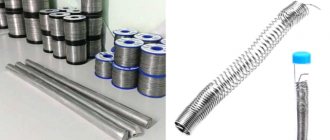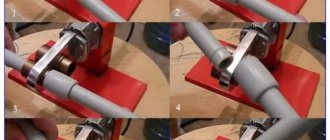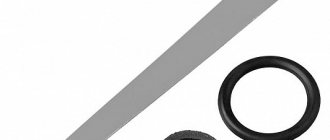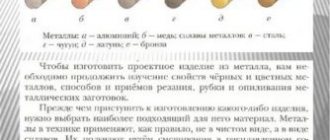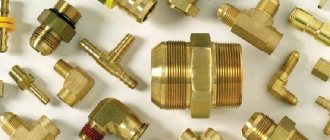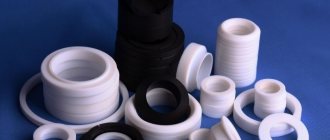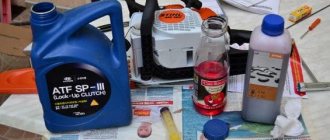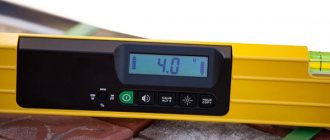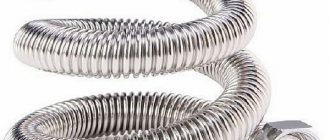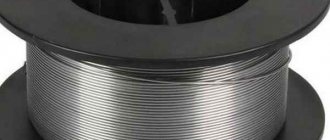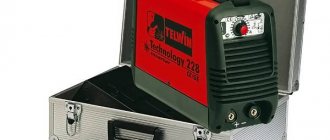When performing metal soldering, there is always a need to use solder, the quality of which directly affects the durability of the completed connection of metal parts. It should be said that solder is a consumable material and is made from various alloys. Manufacturers are constantly improving this material, which ensures high-quality connections and simplifies soldering. Rosin solder is an inexpensive and at the same time high-quality material that is versatile and can be used for soldering various metals.
This solder contains rosin, which eliminates the need to purchase and use additional materials. Rosin simplifies the melting of the surfacing material, which in turn improves the quality of the joint. Another constant advantage of such solder is its low melting point, and this in turn allows you to avoid changing the structure of the base metal being connected.
The flux in the solder is in the form of rosin, so there is no need to use it additionally. This greatly simplifies the soldering procedure, which professionals and ordinary homeowners will appreciate. Note that the percentage of rosin is in the optimal amount, while using it separately, there is a danger of taking more and less material. All this has a positive effect on the quality of welding work performed.
Proper use of a soldering iron
Despite the apparent simplicity of working with a soldering iron, it is very desirable to have initial skills in high-quality work and be able to correctly use solder with rosin.
Soldering is done using a variety of solders. The so-called solder in a rosin reel is perhaps the most popular. When performing work related to soldering, solder is used. The amount of tin and lead it contains is 60 and 40%, respectively. This alloy melts at 180 degrees.
What is needed to work with a soldering iron:
- the soldering iron itself;
- solder;
- rosin.
Heated solder will create a sufficient internal bond with metals such as copper, brass, silver, etc., if the following conditions are met:
- The surfaces of the parts must be cleaned of oxides.
- The part at the soldering site is heated above the melting point of the solder itself.
- During operation, the soldering area must be protected from exposure to oxygen; various fluxes are used for this purpose. They create a protective film directly above the soldering area.
A book on how to solder can be read and understood, but soldering skills can only be learned through practice.
Composition and physicochemical properties
The classic composition of solder with rosin is ordinary soft tin-lead. The lead content in it is 40%, and tin – 60%. Such solders include POS 60 or a similar brand POS 61.
Thanks to this, it acquires special physical properties. Solder with and without rosin with this composition has special flexibility, which helps to select the desired position before soldering. This composition is characterized by a relatively low melting point, which does not allow the use of solder for soldering refractory metals. However, it penetrates well into all irregularities when in a liquid state. This ensures the highest possible degree of grip. Although there is no penetration into the structure of the base metal, this property makes it possible to cover as large a bonding area as possible.
Relatively low melting point ensures ease of use. The presence of lead adds fluidity to the material. When using, it is better to do everything in a well-ventilated area, as lead produces fumes that are harmful to human health.
Technical characteristics of solder with rosin
Among all brands there are those varieties. Which are used most often. Their technical characteristics provide ease of use and make them practically universal for most procedures.
| Brand | Specifications | |||||
| Melting point, °C | Density, gram/cm square | Thermal conductivity | Tensile strength | Relative elongation, % | ||
| Initial | Ultimate | |||||
| POS 61 | 183 | 189 | 8,5 | 0,12 | 4,3 | 46 |
| POS 60 | 185 | 192 | ||||
| POS 90 | 183 | 189 | 47 MPa (or 4.9 kgf/mm square) | 58 | ||
Read also: Diagram of a single-phase reversible motor
Features of choice
When choosing which is better, solder with or without rosin, you should first of all focus on the ease of soldering. If you are faced with standard procedures, the modes of which are well known, then you can choose solder containing rosin of any suitable brand. Most often, the choice falls on materials from the POS series, in which the main components are silver and tin. This allows for softness and high wettability to be achieved at the expense of lower bond strength.
If you have to join refractory metals, then it is better to use special types of solders, which may not contain flux.”
The higher the melting temperature of the base metal, the higher the melting temperature of the solder should be. This is the main indicator by which experts are guided. In addition to the composition of the brand, you also need to decide on the thickness of the wire. It’s already easier here, since everything depends on the thickness of the product itself. When working with a soldering iron, you can always fuse a drop of the desired size from a wire of any thickness, so there will not be much difference here. To work with gas, you already need to choose the appropriate thickness option. In your arsenal it is worth having both minimum values, from 0.8 mm, and larger values of 1.2 and 1.5 mm. But the composition of the material will always be more important than the thickness.
Features of application
Having decided which solder is better, with or without rosin, and also having selected the appropriate brand, you can proceed directly to soldering. As when working with simple solder, the first step is to prepare the surface of the base metal; it needs to be cleaned.
Despite the easier process, the presence of rosin does not eliminate most of the negative factors affecting the quality of soldering.”
After preparation, you need to heat its surface to the desired temperature and start using solder. This is required so that there is not a big contrast between the temperatures of the molten solder and the base metal, so you shouldn’t overheat too much either. After the molten solder spreads over the surface, it must be allowed to cool. Thus, soldering of this type has only one important distinctive feature, since there is no need to use additional flux. Its presence in the composition makes the process as easy as when adding rosin separately.
Popular manufacturers
On the domestic market you can find the following manufacturers of these products:
- KievTsvetMet;
- Solder;
- Vadis-M;
- Technoscrap;
- Manwell;
- "Technological Lines";
- Ukr-Spetssplav;
- Arsenal;
- UkrInterstal.
Every radio amateur or DIY repairman will sooner or later be forced to pick up a soldering iron and try it. The quality of the work performed and even the performance of the product will directly depend on many factors, which you must know about before starting work.
Tricks and secrets of working with a soldering iron
After the solder has begun to melt, it can already be used for soldering. To do this, you need to cover the soldering iron tip with a thin layer of solder, and then wipe it thoroughly on a damp sponge. This is how the solder and rosin remaining from work are removed. It won’t hurt to get into the habit of wiping the tip with a wet sponge every time after soldering.
Before you start soldering a radio component, you need to prepare it. Its leads should be bent so that the part fits freely into the holes intended for it.
Beginners without experience often touch the soldering area with the tip of the soldering iron tip. And you need to hold the soldering iron so that the contact area between it and the place of soldering is as large as possible, otherwise the place where you need to solder does not heat up enough to hold the parts together.
Types of nickel-plated soldering tips
- The needle-shaped tip is used to solder very small radio components, such as SMD. When repairing phones, such a tip is indispensable. It is used on boards with a high density of mounted parts.
- Tip-spatula - used for desoldering and in cases of installation of large radio components. They work with multi-pin microcircuits.
- The tip is in the shape of a drop - it is convenient for them to transfer solder with rosin to the place of soldering, which leads to improved quality of work.
- A tip with a curved shape - most often it is used to solder radio components that are in a copper shell, so that no excess solder remains on the board. It can also be used for regular soldering. The soldering iron heats up to a temperature of 290-300 C.
When working with a soldering iron, you must always keep it perfectly clean. New soldering tips are usually hammered to create fine nicks on the surface. Subsequently, they are carefully trimmed with a file to give the tip the most correct shape.
Then the tip should be tinned using solder with rosin. That is, cover with a thin layer of solder, dipping it in rosin.
Purpose of rosin
Before describing the purpose of rosin, it is necessary to explain the difference between soldering and welding:
- During the welding process, the edges of the parts being joined are melted, the liquid phases mix and, when solidified, form a permanent connection.
- When soldering, the parts to be joined remain in a solid state, and only the metal used for the connection—the solder—melts. The molten solder spreads over the edges being joined and, when solidified, forms a permanent connection.
To guarantee quality, the edges of the parts to be fastened must be well wetted with solder. This is achieved by cleaning them from oxides and contaminants using fluxes - in this case, rosin.
Secrets of soldering with a soldering iron
To obtain a good result when soldering, you must correctly use solder with rosin and flux. This is a low-melting alloy of a special metal that is used to solder the leads of parts and wires.
- The best solder is pure tin. But such metal is too expensive to be used for soldering. Therefore, when working with radio components, so-called lead-tin solders are used.
- Lead with tin. In terms of soldering strength, these solders are no worse than pure tin. They melt at a temperature of 170-190 degrees. It is customary to denote such solders by the abbreviation “POS” - tin-lead solder. The number after these letters in the designation means the share of tin, expressed as a percentage. It is better to use POS-6O solder.
- Fluxes are substances that have antioxidant properties. They are used to prevent oxidation of the soldering area. If you don't use flux, the solder simply won't stick to the metal surface.
Types of rosin solder
Currently, such solder with rosin is manufactured in several versions. It is customary to distinguish such filler material depending on the rosin content, wire thickness and a number of other features. There is a choice of materials for both home use and soldering on an industrial scale. This solder is produced in the form:
- In reels. This is a universal option for surfacing material that can be used by both professional welders in workshops and ordinary homeowners for soldering at home. The thickness of the wire can vary from 0.8 to 2 millimeters. Note that using such coils is extremely convenient. You just need to select the appropriate brand of solder and wire thickness.
- In a tube. This type of solder is made exclusively for home use. Such a tube contains a minimum of material, so if large volumes are needed, you should either buy a large number of tubes at once or choose solder in a coil.
- In the bays. A large amount of material is used, so this design is intended primarily for industrial use. The thickness of the wire can be varied, depending on the specific needs of customers. The coils themselves can be made in different sizes, which somewhat simplifies their use.
Physico-chemical properties of the solder used
The classic composition of such solder with rosin is considered to be tin-lead soft alloys. The tin content is 60% and lead 40%. Accordingly, such a composition gives such solder certain physical properties. The presence of rosin allows for excellent flexibility, as a result of which, before welding, you can select the right amount of such material and correctly position it in the seam. It must be taken into account that such a composition has a low melting point, so it is not possible to use it for joining refractory metals. At the same time, we note that such solder penetrates in a liquid state into all cavities and irregularities, which ensures the strength of the connection. But at the same time, such an additive does not penetrate into the base material.
Low melting temperatures ensure ease of soldering. Lead adds fluidity to the material, but one should take into account the fact that lead may contain toxic fumes, so it is best to perform soldering in a ventilated area. No further precautions are required when soldering.
Types of fluxes
When working with radio components, fluxes that do not contain acid are used. For example, rosin. Bow rosin for lubricating musical instruments is also sold in stores. It can also be used for soldering. But metal utensils are soldered using solder without rosin. To repair it you will need “soldering acid”. This is zinc dissolved in hydrochloric acid. It is also impossible to solder radio components with such solder, since over time it will destroy the soldering.
If you need to solder in hard-to-reach places, you need to have liquid flux. You can make it yourself. Rosin is crushed into powder and poured into acetone or ethyl alcohol. After mixing the solution, you need to add more rosin until you obtain a thick, mushy mass. Such liquid rosin should be applied to soldering areas with a brush or stick. However, there is a nuance - to work with printed circuit boards, the flux must be more liquid. For hard-to-reach places, you can also use wire solder with rosin, which is much more convenient.
When working with various fluxes, it is necessary to take into account that those that contain acetone are very toxic. Therefore, when working with them, it is necessary to avoid getting vapors into the respiratory tract. It is better to solder near a window if it is summer, and in winter it is better to ventilate the room in which the work is being carried out. After finishing work, be sure to wash your hands with soap and warm water.
How to solder with rosin
An important condition for successful soldering is maintaining the cleanliness of the surfaces that need to be soldered. Be sure to clean the soldering areas until they shine. Then the parts need to be placed on a piece of rosin and warmed up. The melted rosin will help the solder spread evenly over the conductor or part that needs to be soldered. You can carefully rotate the part while moving the soldering iron tip over it so that the solder spreads in an even layer over the surface.
If you need to tin a conductor that is soldered into a board, then after cleaning the soldering area with sanding paper or a knife, you need to bring a piece of rosin, and then smoothly distribute the solder as evenly as possible, using a soldering iron.
The quality of soldering is also affected by how correctly the wires or contacts of the parts are connected during soldering. They should be pressed tightly together and then bring the soldering iron to the prepared conductors, touching it. After the heated solder has spread over the surface, filling even small gaps between them, the soldering iron should be removed.
Continuous soldering time should be no more than five seconds. After this period of time, the solder will harden and the parts will be firmly connected. However, to prevent the soldering from breaking, the parts should not be moved for 10-15 seconds after soldering is completed. Otherwise the connection will not be strong.
If work is done with transistors, then their terminals must be protected so as not to overheat. It is better to hold them either with pliers or tweezers, thereby dissipating heat.
When soldering radio components, you should never twist the ends of the parts. If you need to resolder parts or replace conductors, you need to think about this in advance, before starting installation. It is best to solder the ends of the parts at a short distance from each other, and not in one place.
